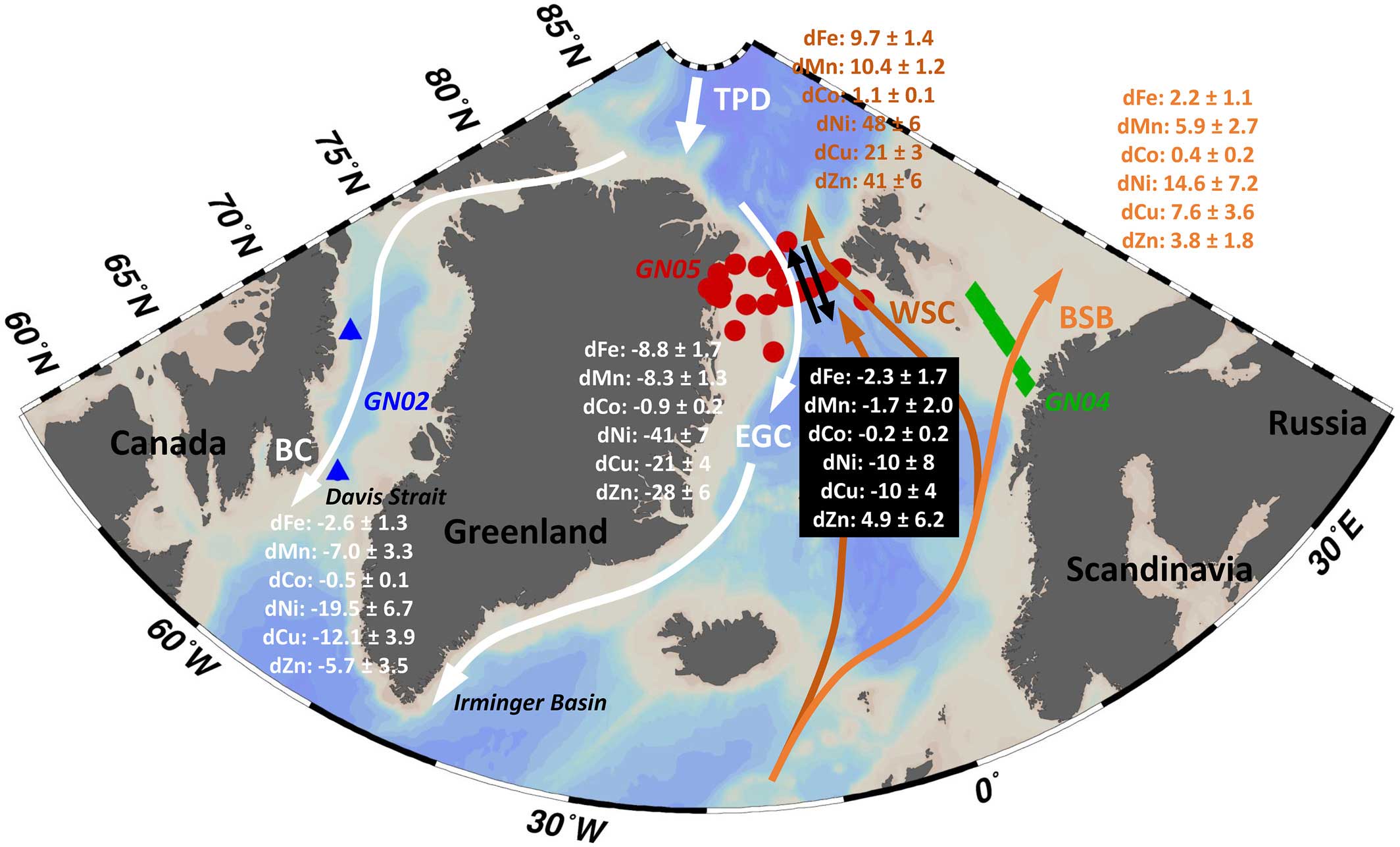The Arctic Ocean is a net source of micronutrients toward the North Atlantic through the gateway of Fram Strait
Because of its intra-continental character and the shelves surrounding it, large parts of the surface Arctic Ocean are enriched in micronutrients such as dissolved iron (dFe), manganese (dMn), cobalt (dCo), nickel (dNi), copper (dCu) and zinc (dZn). Previous studies have suggested that the Arctic Ocean exports micronutrients into the Atlantic Ocean (e.g. Klunder et al 2012, Charette et al. 2020), which may stimulate primary production and atmospheric CO2 drawdown in regions downstream to the Arctic-Atlantic gateways. However, until now, micronutrient data from across the Arctic-Atlantic gateways has been missing and so the extent of Arctic micronutrient transport toward the Atlantic Ocean remained unquantified. In their current study, Krisch and colleagues (2022, see reference below) present a flux budget for micronutrient exchange between the Arctic and the North Atlantic Ocean at the gateways of Fram Strait, Davis Strait and the Barents Sea Opening. Based on micronutrient data from GEOTRACES cruise GN05, this study suggests that the Arctic Ocean is a net source of dFe, dNi and dCu, and possibly also of dCo and dMn, through Fram Strait and toward the North Atlantic. In contrast, Arctic dZn export toward the Atlantic was smaller than dZn import into the Arctic Ocean. By comparing micronutrient properties to observations in the Central Arctic, the authors trace the source of micronutrients exported with surface waters through Fram Strait as largely derived from Siberian riverine discharge and shelf sediments sources located more than 3,000 km away. This predicts that increasing Arctic river discharge, permafrost thaw and coastal erosion, all consequences of climate change may alter future Arctic Ocean micronutrient transport to the North Atlantic Ocean.

Figure: Schematic of the flow paths of major water masses across the Arctic-Atlantic gateways of Fram Strait, Davis Strait and the Barents Sea Opening. The warm and saline West Spitsbergen Current (WSC) and the Barents Sea Branch (BSB) transport Atlantic-derived micronutrients into the Arctic Ocean (depicted as orange/brown arrows), whereas the cold and fresh East Greenland Current (EGC) and Baffin Current (BC) transport Arctic-derived micronutrients toward the North Atlantic (depicted in white arrows). Values (in Gg per year) in the black box refer to the net exchange rates across Fram Strait.
References:
Krisch, S., Hopwood, M. J., Roig, S., Gerringa, L. J. A., Middag, R., Rutgers van der Loeff, M. M., Petrova, M. V., Lodeiro, P., Colombo, M., Cullen, J. T., Jackson, S. L., Heimbürger‐Boavida, L., & Achterberg, E. P. (2022). Arctic – Atlantic exchange of the dissolved micronutrients Iron, Manganese, Cobalt, Nickel, Copper and Zinc with a focus on Fram Strait. Global Biogeochemical Cycles. doi:10.1029/2021gb007191
Charette, M. A., Kipp, L. E., Jensen, L. T., Dabrowski, J. S., Whitmore, L. M., Fitzsimmons, J. N., et al. (2020). The transpolar drift as a source of riverine and shelf-derived trace elements to the central Arctic Ocean. Journal of Geophysical Research: Oceans, 125(5), doi:10.1029/2019jc015920
Klunder, M. B., Bauch, D., Laan, P., de Baar, H. J. W., van Heuven, S., & Ober, S. (2012). Dissolved iron in the Arctic shelf seas and surface waters of the central Arctic Ocean: Impact of Arctic river water and ice-melt. Journal of Geophysical Research: Oceans, 117(C1). doi:10.1029/2011jc007133
